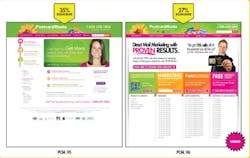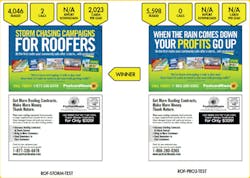Jessica Lalau of PostcardMania, a marketing company specializing in direct mail, explains how you can improve an already successful postcard campaign with split testing.
QUESTION:
How often should I change the look of my postcard if it is getting me the number of new patients I expect?
ANSWER:
It's awesome that your postcards are getting good results. Well done!
As far as changing the design, you need to proceed with caution if you're already getting a great ROI. If you're feeling the urge to switch things up, don't just scrap your postcard campaign and start a new campaign from scratch. Start slowly—and I mean one-change-at-a-time slowly.
I'm talking about split testing, which is also called A/B testing. Split testing is a method of examining the effectiveness of two similar campaigns by comparing them directly with the aim of eliminating the losing postcard campaign from your marketing efforts.
At PostcardMania, we split test everything—including our postcards, our web pages, and our pay-per-click ads—because we want to make sure we're always getting the best results possible. Split testing works especially well for digital marketing because you can get immediate, detailed reports that make it easy to determine the winner.
Here's a split test we did for our pay-per-click advertising:
And here's one we did on our home page:
You can see that the page on the right had an 8% lower bounce rate (the bounce rate is the percentage of people who navigated away from our site without visiting any other pages), so it was the clear winner. Our CEO preferred the page on the left by a lot. She was shocked the other page won! A split test helps you look at the cold hard facts; the design you like better won't necessarily be the one that works best.
Split testing works the same way with direct mail, albeit with slightly less guaranteed precision. It's the best way to continually improve your ROI. Here's how it works: Split your mailing list in half. Send your existing postcard to one half of the list (that's your "control" or "A") and send a second postcard to the other half (that's your "variable" or "B"). You can split test completely different designs or designs that are just slightly different. If you're pleased with the ROI on your current design, I suggest testing one change at the time, starting with the offer, the headline or text, or the colors.
Here's a test, featuring two different headlines, that we sent to prospects in the roofing industry:
The bigger your test mailing, the more confident you can be in the results—a test mailing of 5,000 to 10,000 cards is a good place to start. If that's beyond your budget, you can always split test with fewer postcards, but your results won't be as reliable. Once you send them out, start tracking your results.
Tracking results can be tricky with a postcard campaign. First of all, your front desk should always ask how new leads heard about your practice. And if they say "your website," the front desk should find out how they got there! Second, I would recommend you use two separate call-tracking numbers and two different URLs that redirect to your home page on your split-test postcards. These will give you hard numbers to show which version got the better response.
So you track your responses. Say you sent out 5,000 "A" postcards and 5,000 "B" postcards. You got 83 calls from Postcard A, and 60 calls from Postcard B. Postcard A is the winner, right? Not necessarily.
Look at all of the numbers. How many of those callers made appointments? What kind of services did they require? In other words, what was the quality of the leads? What was your ROI?
Here's an example:
In this case, even though Postcard A got more initial calls, Postcard B actually generated more ROI, making it the winner. Postcard B should be your new postcard as well as the control for your next split test.
Whichever aspect of your postcard campaign you change, give it at least three mailings over a period of at least three months before analyzing the results, for two reasons: (1) Calls will start coming in four to six weeks after each mailing, and it can take months for patients to come in for their first appointments; and (2) most prospective patients need to see your marketing message more than once before they'll respond to it.
Think about it. How many times have you seen the same commercial over and over? There's a good reason. People need to hear your message multiple times before it sinks in. Repetition is vital. In fact, 70% of our successful dental clients send their postcards at least twice, and 60% mail them three times or more. So before you decide a new postcard design isn't working, make sure you've sent it at least three times.
There you have it. When you feel the urge to change up your postcard campaign, you need to test, test, test until you get it right!
Have a dental marketing question? Send it to me at [email protected], and you might be featured next!
MORE READING:
Let's play 'good postcard or bad postcard'
How to design a results-generating dental marketing postcard
5 things you should remove from your dental practice postcard mailer
Jessica Lalau is the director of marketing communications, public relations, and social media at PostcardMania, a $22-million marketing company specializing in direct mail. Since its founding in 1998, PostcardMania has delivered results-driven marketing campaigns for more than 4,600 dental professionals across the nation. To request free dental industry postcard samples (with postage included), visit PostcardMania.com.











